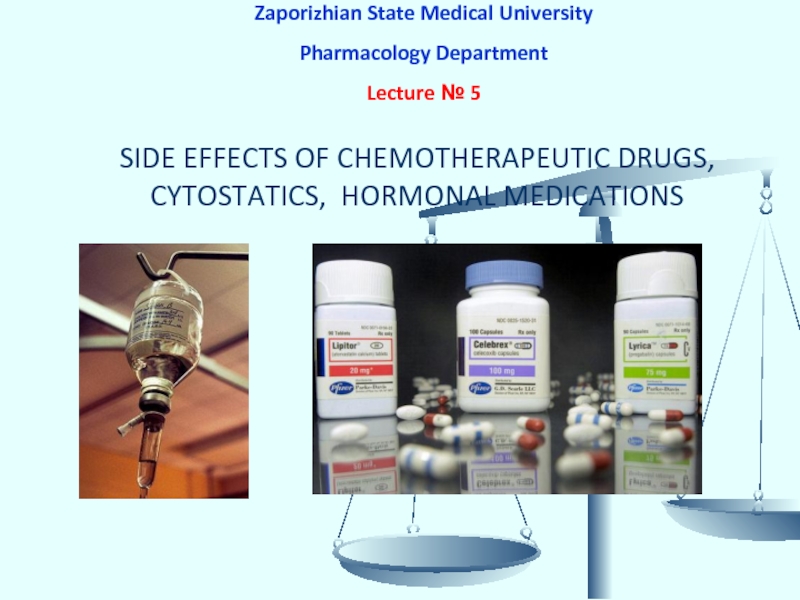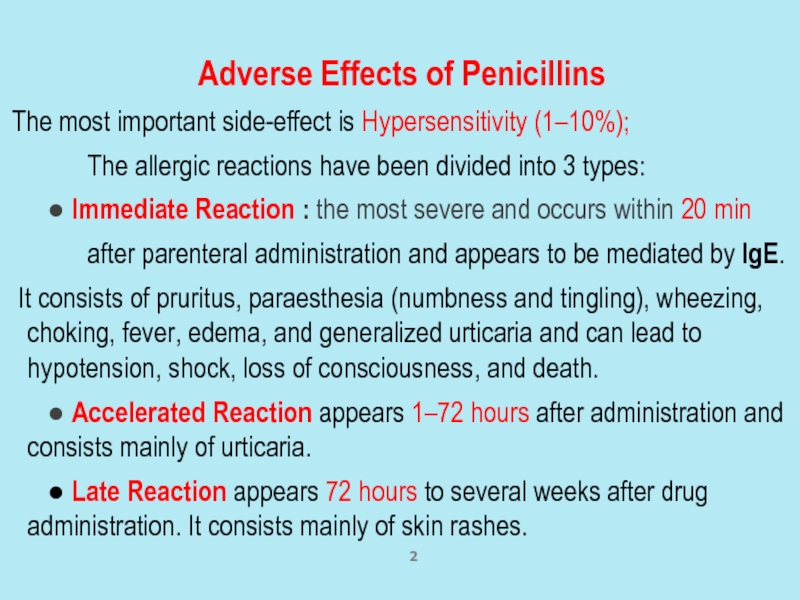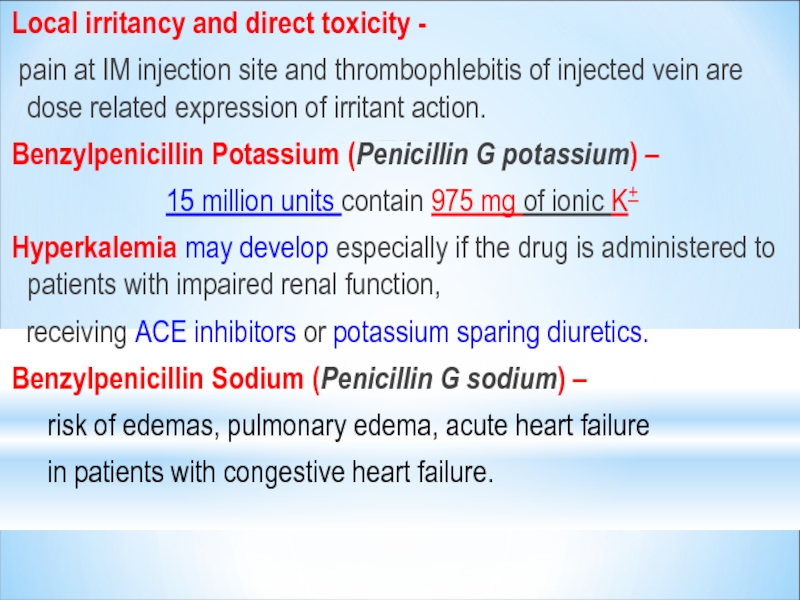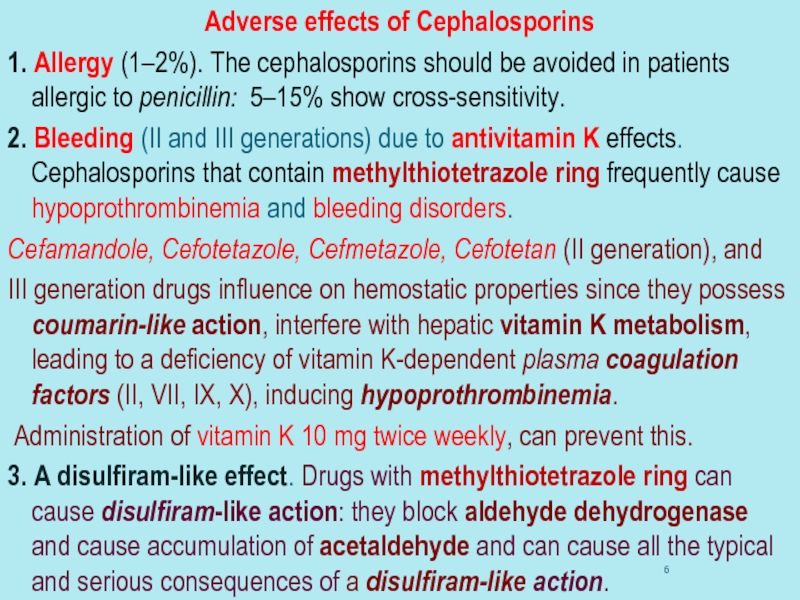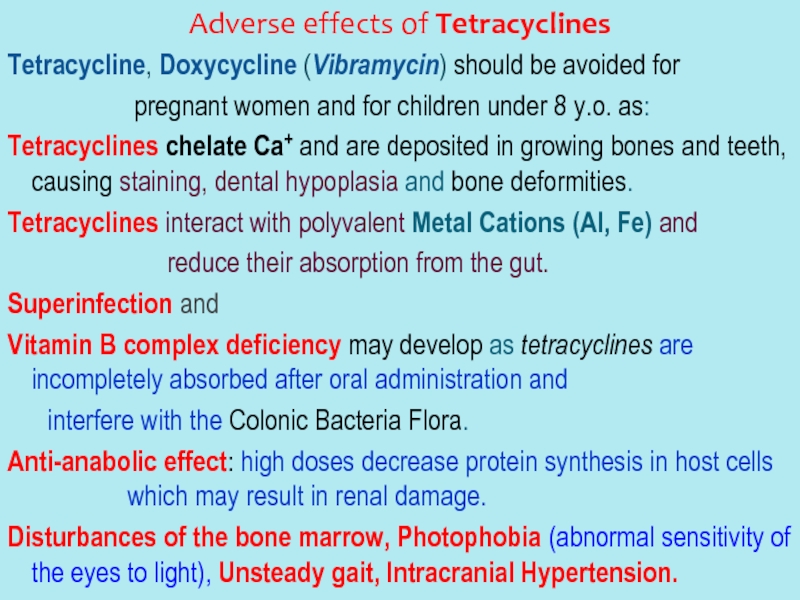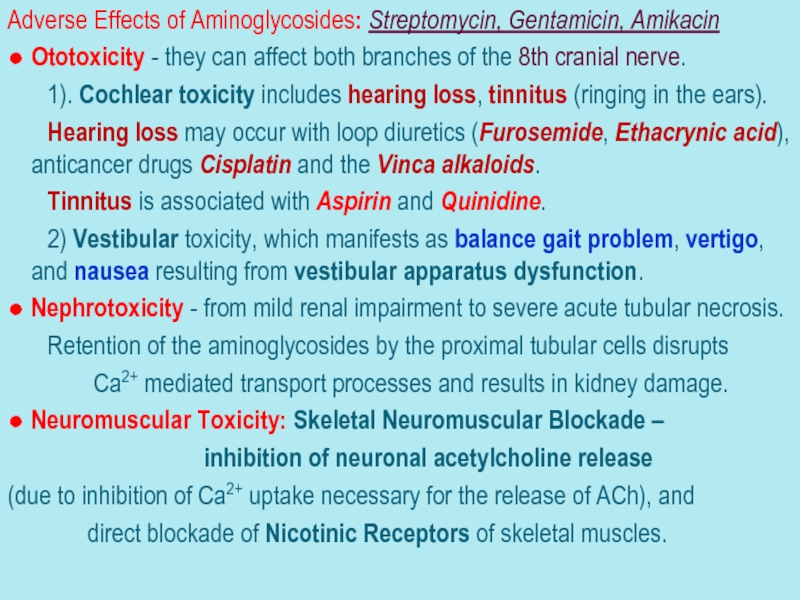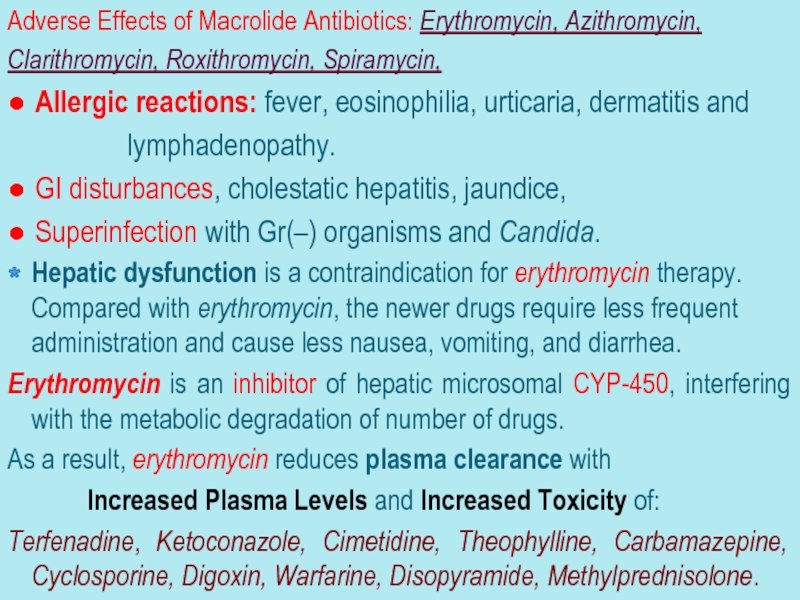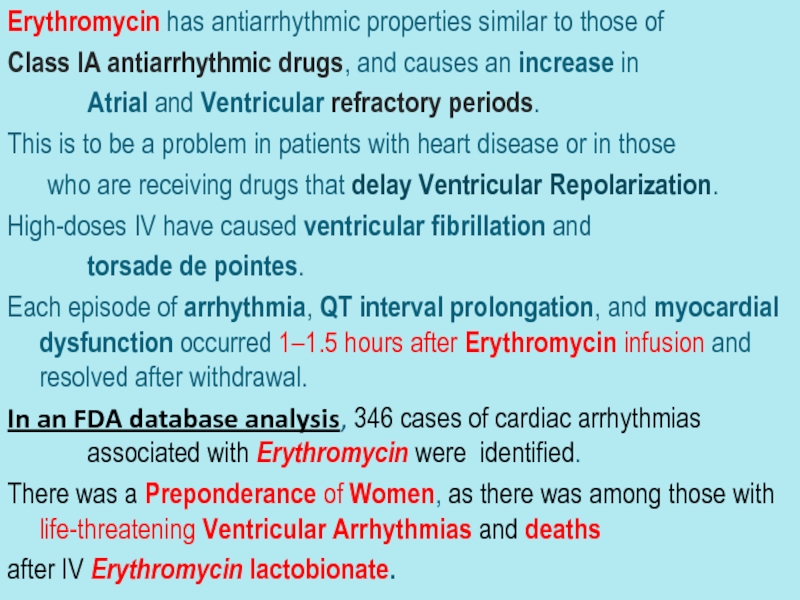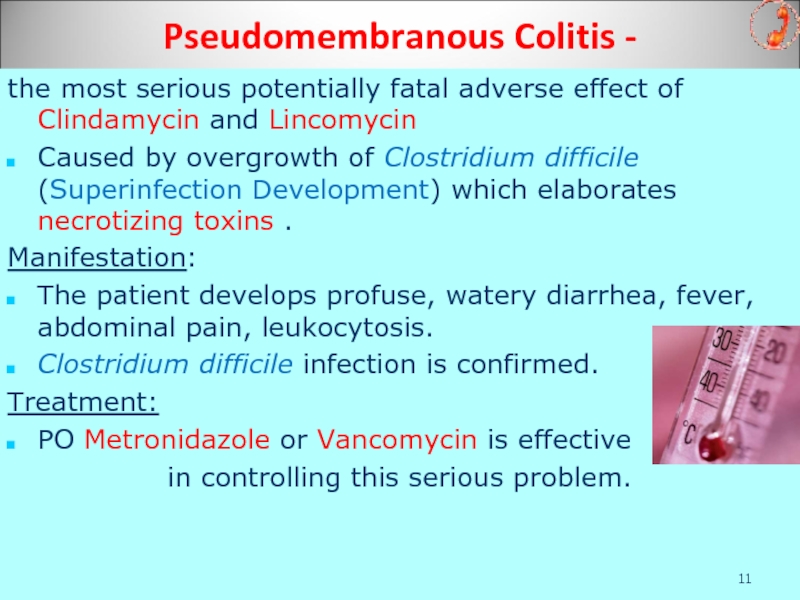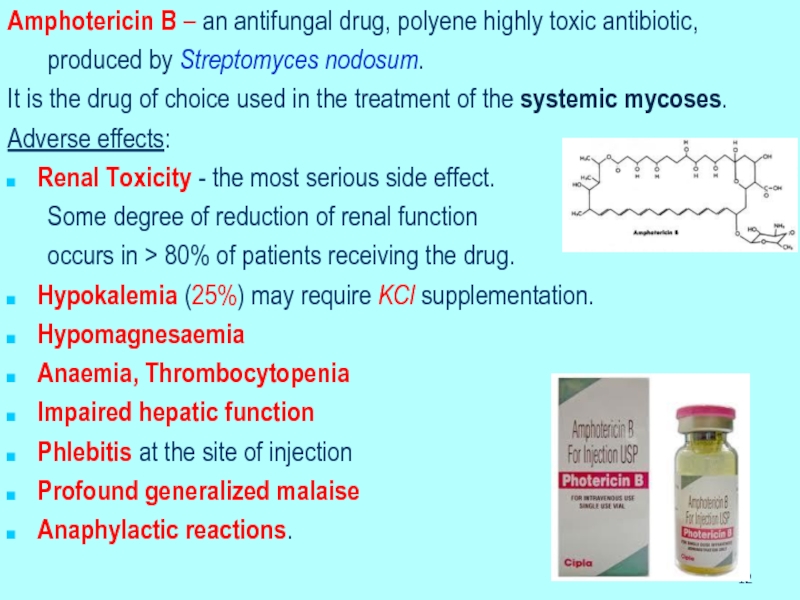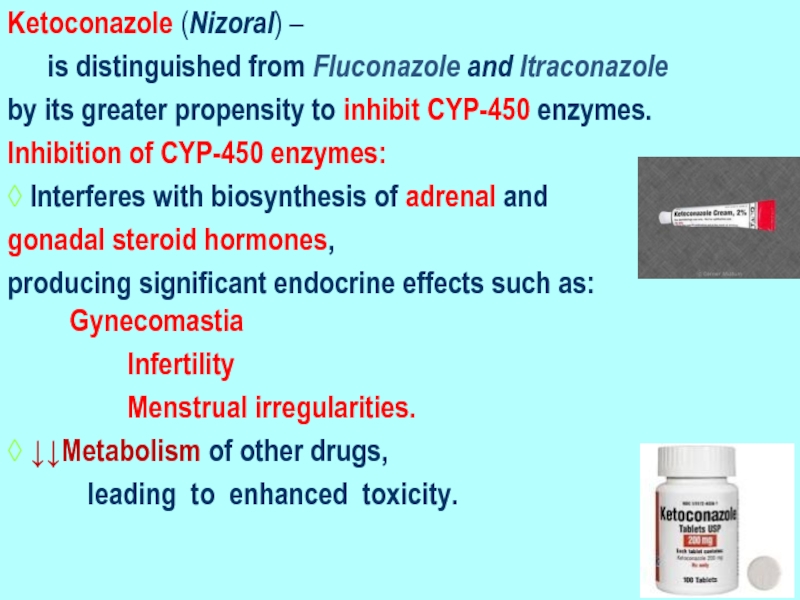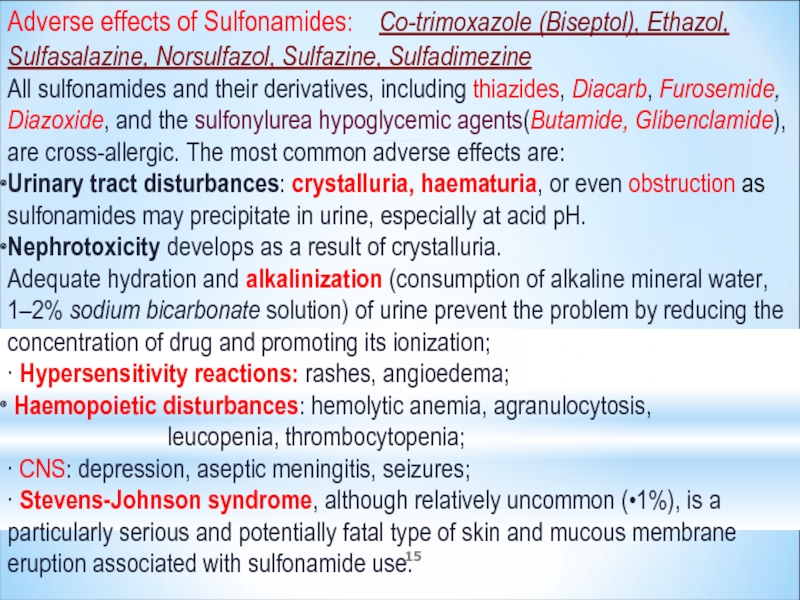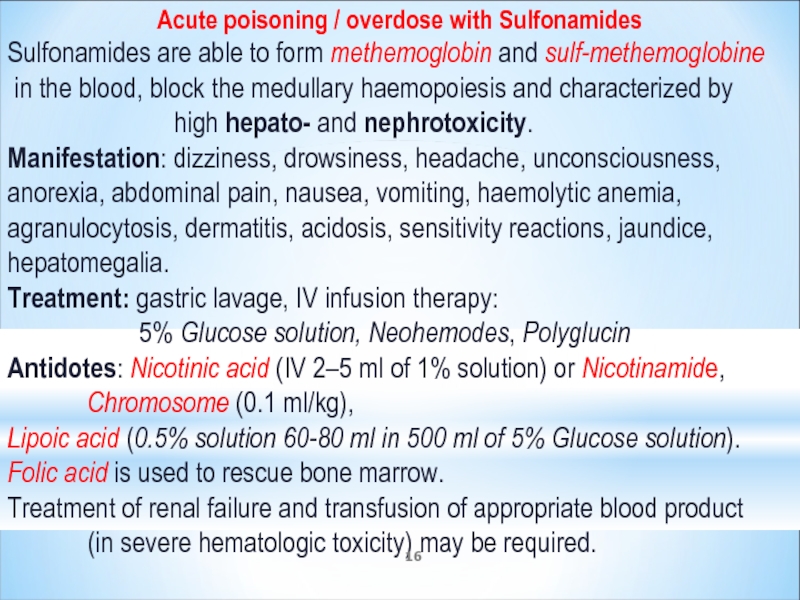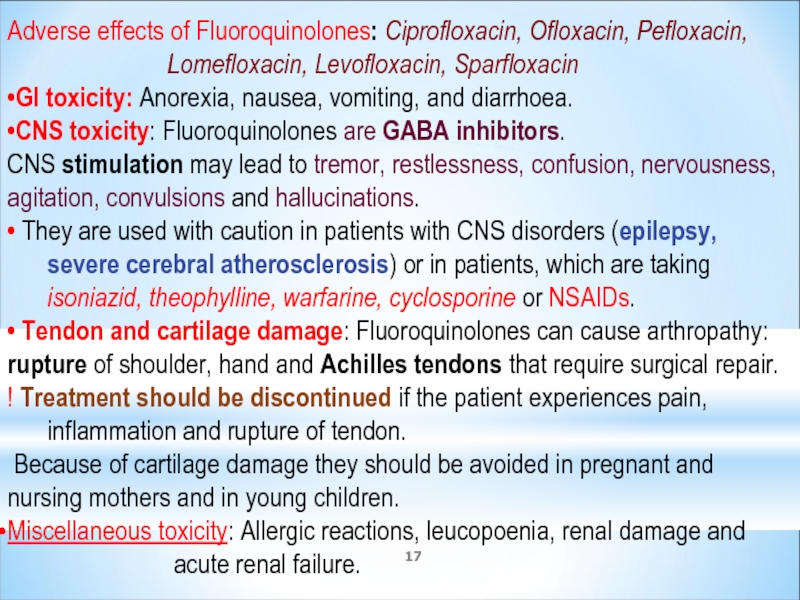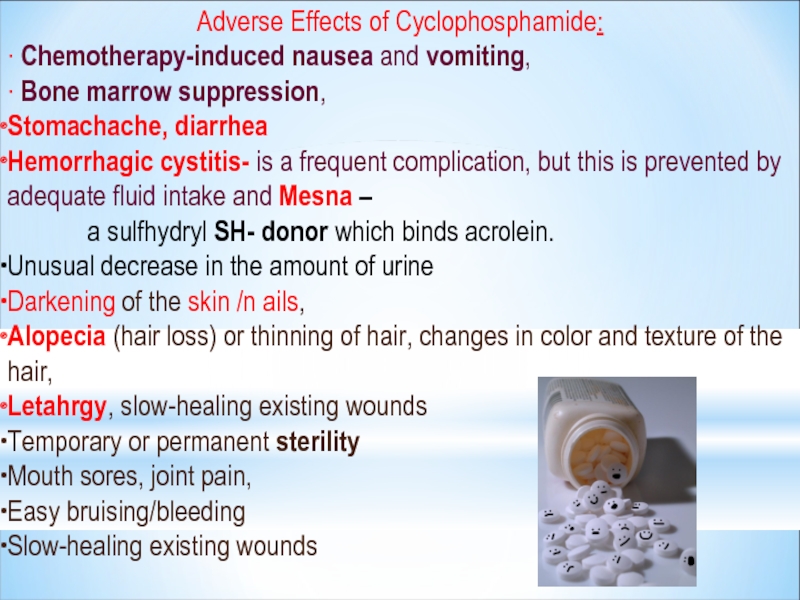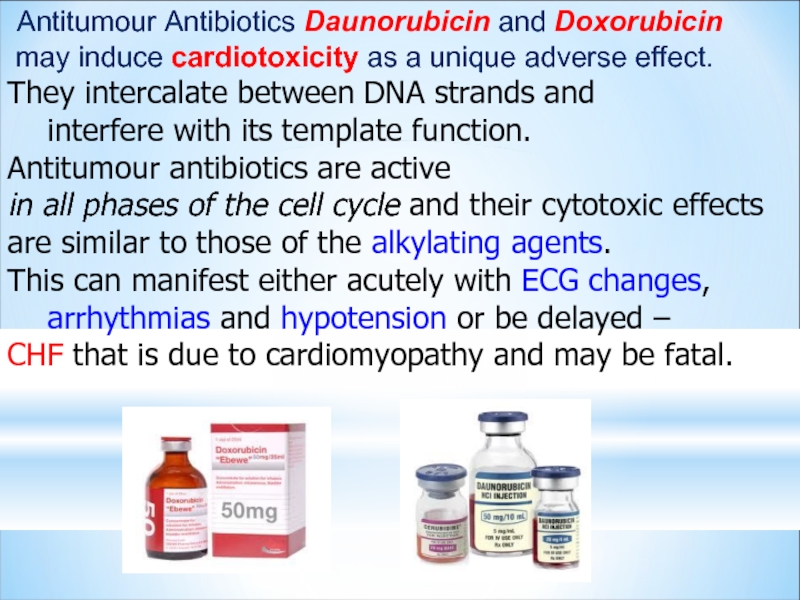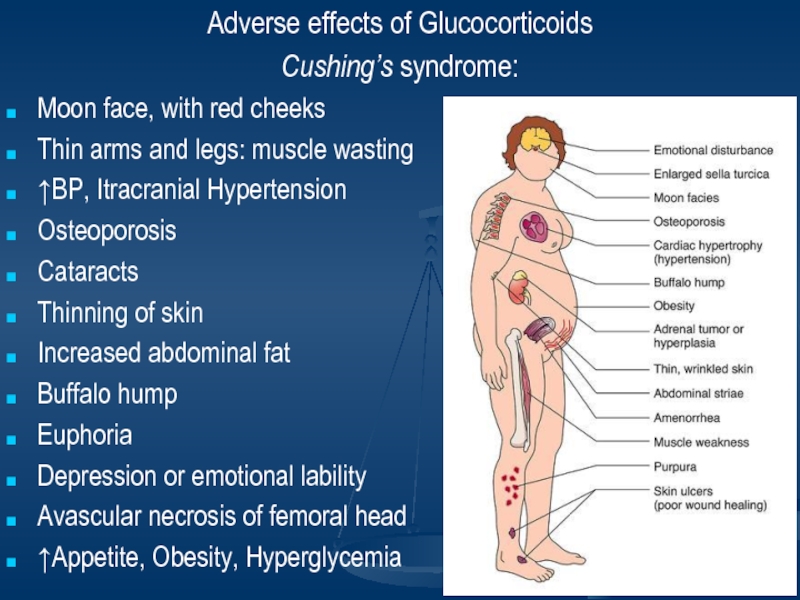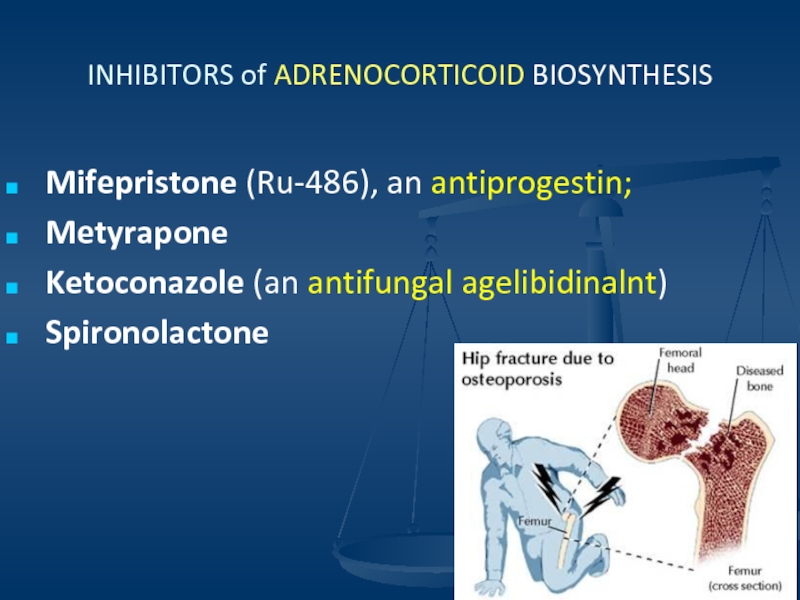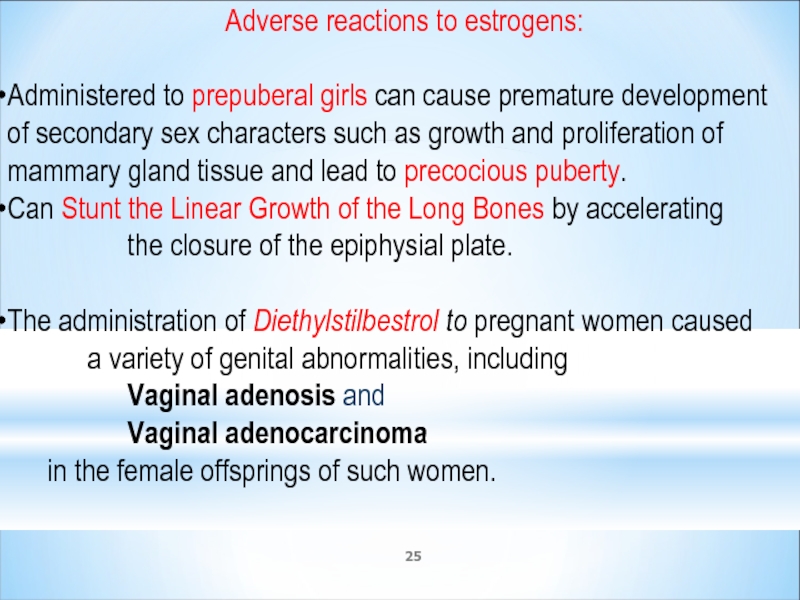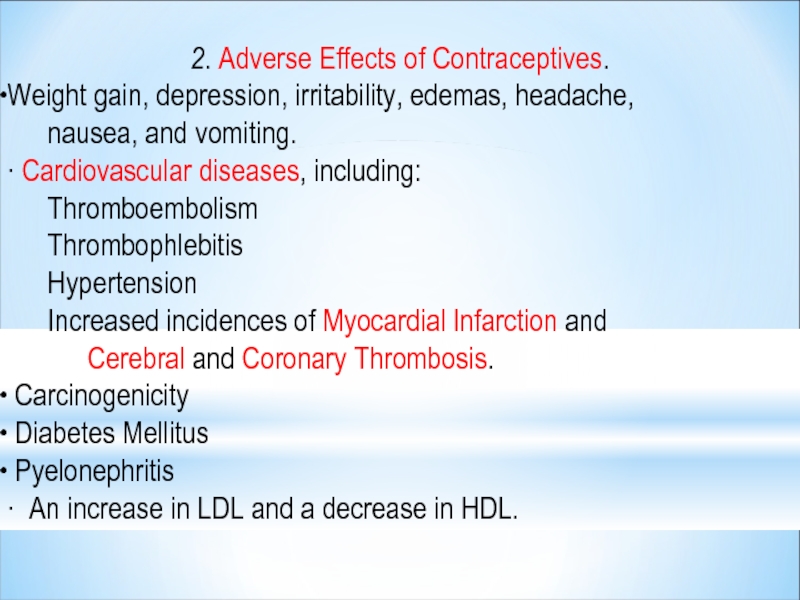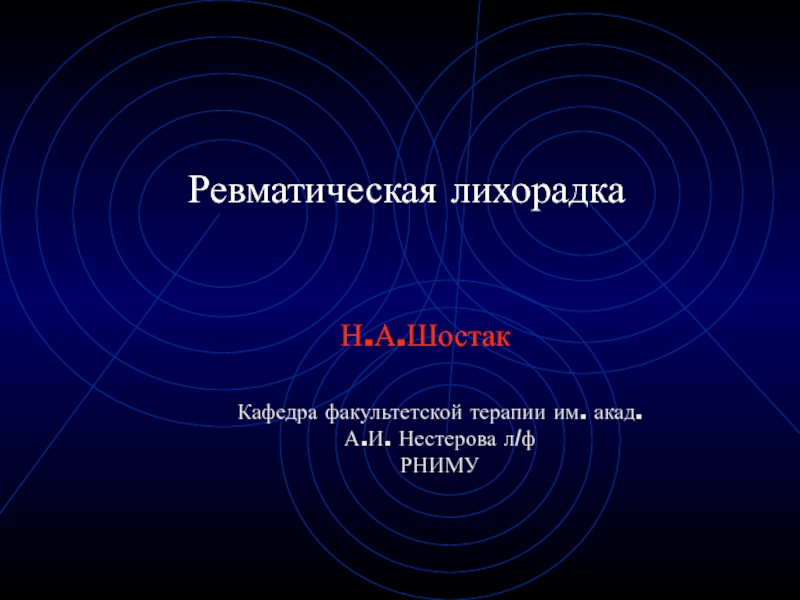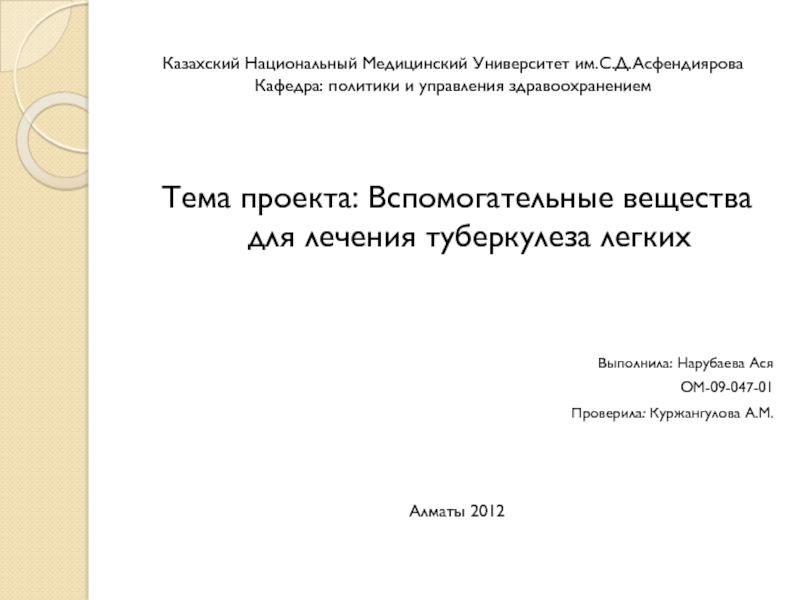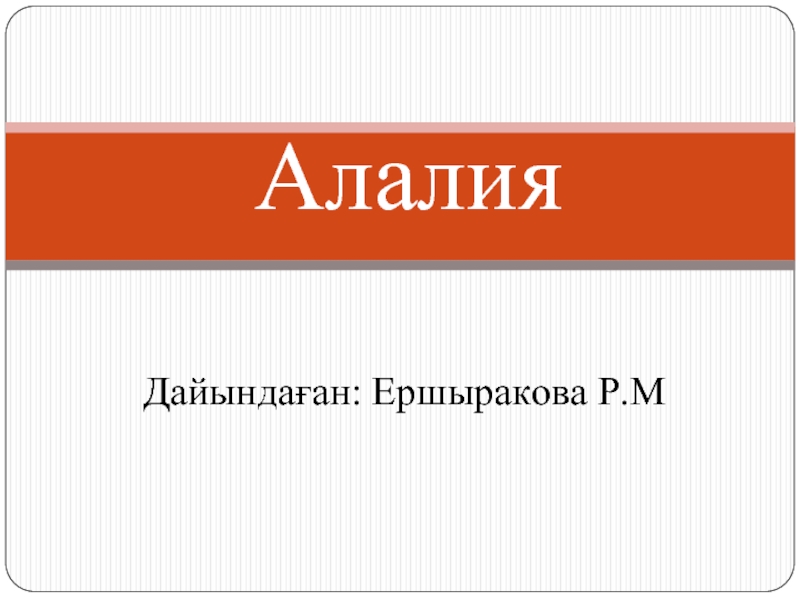Department
Lecture № 5
- Главная
- Разное
- Дизайн
- Бизнес и предпринимательство
- Аналитика
- Образование
- Развлечения
- Красота и здоровье
- Финансы
- Государство
- Путешествия
- Спорт
- Недвижимость
- Армия
- Графика
- Культурология
- Еда и кулинария
- Лингвистика
- Английский язык
- Астрономия
- Алгебра
- Биология
- География
- Детские презентации
- Информатика
- История
- Литература
- Маркетинг
- Математика
- Медицина
- Менеджмент
- Музыка
- МХК
- Немецкий язык
- ОБЖ
- Обществознание
- Окружающий мир
- Педагогика
- Русский язык
- Технология
- Физика
- Философия
- Химия
- Шаблоны, картинки для презентаций
- Экология
- Экономика
- Юриспруденция
Side effects of chemotherapeutic drugs, cytostatics, hormonal medications презентация
Содержание
- 1. Side effects of chemotherapeutic drugs, cytostatics, hormonal medications
- 2. Adverse Effects of Penicillins The
- 3. Non-allergic Reactions to Penicillins ●Transient palpitation,
- 4. Local irritancy and direct toxicity -
- 5. Superinfection- in the form of Intestinal or
- 6. Adverse effects of Cephalosporins 1. Allergy (1–2%).
- 7. Adverse effects of Tetracyclines Tetracycline, Doxycycline
- 8. Adverse Effects of Aminoglycosides: Streptomycin, Gentamicin, Amikacin
- 9. Adverse Effects of Macrolide Antibiotics: Erythromycin, Azithromycin,
- 10. Erythromycin has antiarrhythmic properties similar to those
- 11. Pseudomembranous Colitis - the most serious potentially
- 12. Amphotericin B – an antifungal drug, polyene
- 13. Synthetic Antifungal Agents – Azoles: Miconazole,
- 14. Ketoconazole (Nizoral) – is distinguished from
- 15. Adverse effects of Sulfonamides: Co-trimoxazole (Biseptol),
- 16. Acute poisoning / overdose with Sulfonamides Sulfonamides
- 17. Adverse effects of Fluoroquinolones: Ciprofloxacin, Ofloxacin, Pefloxacin,
- 18. Isoniazid (isonicotinic acid hydrazide – INH) -
- 19. Adverse Effects of Cyclophosphamide: ∙ Chemotherapy-induced nausea
- 20. ∙ High-dose Cyclophosphamide (120–200 mg/kg) can cause
- 21. Antitumour Antibiotics Daunorubicin and Doxorubicin
- 22. Adverse effects of Glucocorticoids Cushing’s syndrome:
- 23. INHIBITORS of ADRENOCORTICOID BIOSYNTHESIS Mifepristone
- 24. Adverse Reactions to Estrogens: 1.Those following
- 25. Adverse reactions to estrogens: Administered to
- 26. 2. Adverse Effects of Contraceptives.
Слайд 1SIDE EFFECTS OF CHEMOTHERAPEUTIC DRUGS, CYTOSTATICS, HORMONAL MEDICATIONS
Zaporizhian State Medical University
Pharmacology
Слайд 2
Adverse Effects of Penicillins
The most important side-effect is Hypersensitivity (1–10%);
The allergic reactions have been divided into 3 types:
● Immediate Reaction : the most severe and occurs within 20 min
after parenteral administration and appears to be mediated by IgE.
It consists of pruritus, paraesthesia (numbness and tingling), wheezing, choking, fever, edema, and generalized urticaria and can lead to hypotension, shock, loss of consciousness, and death.
● Accelerated Reaction appears 1–72 hours after administration and consists mainly of urticaria.
● Late Reaction appears 72 hours to several weeks after drug administration. It consists mainly of skin rashes.
Слайд 3
Non-allergic Reactions to Penicillins
●Transient palpitation, Hypertension.
●Toxicity to the brain may manifest
as mental confusion, twitching, auditory and visual disturbances, convulsions and coma, when large doses >20 MU, esp. Novocaine Benzylpenicillin, are injected.
Novocaine Benzylpenicillin may produce CNS stimulation with
psychiatric symptoms like fear of imminent death,
acute depersonalization and hallucinations.
Being insoluble, it can also cause microembolism.
Bleeding has occurred with high doses due to interference with platelet function.
Novocaine Benzylpenicillin may produce CNS stimulation with
psychiatric symptoms like fear of imminent death,
acute depersonalization and hallucinations.
Being insoluble, it can also cause microembolism.
Bleeding has occurred with high doses due to interference with platelet function.
Слайд 4Local irritancy and direct toxicity -
pain at IM injection
site and thrombophlebitis of injected vein are dose related expression of irritant action.
Benzylpenicillin Potassium (Penicillin G potassium) –
15 million units contain 975 mg of ionic K+
Hyperkalemia may develop especially if the drug is administered to patients with impaired renal function,
receiving ACE inhibitors or potassium sparing diuretics.
Benzylpenicillin Sodium (Penicillin G sodium) –
risk of edemas, pulmonary edema, acute heart failure
in patients with congestive heart failure.
Benzylpenicillin Potassium (Penicillin G potassium) –
15 million units contain 975 mg of ionic K+
Hyperkalemia may develop especially if the drug is administered to patients with impaired renal function,
receiving ACE inhibitors or potassium sparing diuretics.
Benzylpenicillin Sodium (Penicillin G sodium) –
risk of edemas, pulmonary edema, acute heart failure
in patients with congestive heart failure.
Слайд 5Superinfection- in the form of Intestinal or Urinary Infection,
Pneumonia or
Bacteraemia may develop due to overgrowth
such resistant organism as
Klebsiella
Aerobacter
Pseudomonas auroginosa
Candida albicans
E.g., Candida albicans is a normal resident of the vagina and GIT.
An antibiotic may destroy the normal bacterial flora without affecting
the fungal organism. As a result, Candida albicans can proliferate and cause
CANDIDIASIS, manifesting as diarrhea,
soreness and redness of the mouth (thrush), glossitis, and vaginitis.
Nystatin is used for the prevention of fungal infections and for
the treatment of oropharyngeal, vaginal and perineal lesions.
Amphotericin B is administered for serious systemic fungal infections.
.
such resistant organism as
Klebsiella
Aerobacter
Pseudomonas auroginosa
Candida albicans
E.g., Candida albicans is a normal resident of the vagina and GIT.
An antibiotic may destroy the normal bacterial flora without affecting
the fungal organism. As a result, Candida albicans can proliferate and cause
CANDIDIASIS, manifesting as diarrhea,
soreness and redness of the mouth (thrush), glossitis, and vaginitis.
Nystatin is used for the prevention of fungal infections and for
the treatment of oropharyngeal, vaginal and perineal lesions.
Amphotericin B is administered for serious systemic fungal infections.
.
Слайд 6Adverse effects of Cephalosporins
1. Allergy (1–2%). The cephalosporins should be avoided
in patients allergic to penicillin: 5–15% show cross-sensitivity.
2. Bleeding (II and III generations) due to antivitamin K effects. Cephalosporins that contain methylthiotetrazole ring frequently cause hypoprothrombinemia and bleeding disorders.
Cefamandole, Cefotetazole, Cefmetazole, Cefotetan (II generation), and
III generation drugs influence on hemostatic properties since they possess coumarin-like action, interfere with hepatic vitamin K metabolism, leading to a deficiency of vitamin K-dependent plasma coagulation factors (II, VII, IX, X), inducing hypoprothrombinemia.
Administration of vitamin K 10 mg twice weekly, can prevent this.
3. A disulfiram-like effect. Drugs with methylthiotetrazole ring can cause disulfiram-like action: they block aldehyde dehydrogenase and cause accumulation of acetaldehyde and can cause all the typical and serious consequences of a disulfiram-like action.
2. Bleeding (II and III generations) due to antivitamin K effects. Cephalosporins that contain methylthiotetrazole ring frequently cause hypoprothrombinemia and bleeding disorders.
Cefamandole, Cefotetazole, Cefmetazole, Cefotetan (II generation), and
III generation drugs influence on hemostatic properties since they possess coumarin-like action, interfere with hepatic vitamin K metabolism, leading to a deficiency of vitamin K-dependent plasma coagulation factors (II, VII, IX, X), inducing hypoprothrombinemia.
Administration of vitamin K 10 mg twice weekly, can prevent this.
3. A disulfiram-like effect. Drugs with methylthiotetrazole ring can cause disulfiram-like action: they block aldehyde dehydrogenase and cause accumulation of acetaldehyde and can cause all the typical and serious consequences of a disulfiram-like action.
Слайд 7Adverse effects of Tetracyclines
Tetracycline, Doxycycline (Vibramycin) should be avoided for
pregnant women and for children under 8 y.o. as:
Tetracyclines chelate Ca+ and are deposited in growing bones and teeth, causing staining, dental hypoplasia and bone deformities.
Tetracyclines interact with polyvalent Metal Cations (Al, Fe) and
reduce their absorption from the gut.
Superinfection and
Vitamin B complex deficiency may develop as tetracyclines are incompletely absorbed after oral administration and
interfere with the Colonic Bacteria Flora.
Anti-anabolic effect: high doses decrease protein synthesis in host cells which may result in renal damage.
Disturbances of the bone marrow, Photophobia (abnormal sensitivity of the eyes to light), Unsteady gait, Intracranial Hypertension.
Tetracyclines chelate Ca+ and are deposited in growing bones and teeth, causing staining, dental hypoplasia and bone deformities.
Tetracyclines interact with polyvalent Metal Cations (Al, Fe) and
reduce their absorption from the gut.
Superinfection and
Vitamin B complex deficiency may develop as tetracyclines are incompletely absorbed after oral administration and
interfere with the Colonic Bacteria Flora.
Anti-anabolic effect: high doses decrease protein synthesis in host cells which may result in renal damage.
Disturbances of the bone marrow, Photophobia (abnormal sensitivity of the eyes to light), Unsteady gait, Intracranial Hypertension.
Слайд 8Adverse Effects of Aminoglycosides: Streptomycin, Gentamicin, Amikacin
● Ototoxicity - they
can affect both branches of the 8th cranial nerve.
1). Cochlear toxicity includes hearing loss, tinnitus (ringing in the ears).
Hearing loss may occur with loop diuretics (Furosemide, Ethacrynic acid), anticancer drugs Cisplatin and the Vinca alkaloids.
Tinnitus is associated with Aspirin and Quinidine.
2) Vestibular toxicity, which manifests as balance gait problem, vertigo, and nausea resulting from vestibular apparatus dysfunction.
● Nephrotoxicity - from mild renal impairment to severe acute tubular necrosis.
Retention of the aminoglycosides by the proximal tubular cells disrupts
Ca2+ mediated transport processes and results in kidney damage.
● Neuromuscular Toxicity: Skeletal Neuromuscular Blockade –
inhibition of neuronal acetylcholine release
(due to inhibition of Ca2+ uptake necessary for the release of ACh), and
direct blockade of Nicotinic Receptors of skeletal muscles.
1). Cochlear toxicity includes hearing loss, tinnitus (ringing in the ears).
Hearing loss may occur with loop diuretics (Furosemide, Ethacrynic acid), anticancer drugs Cisplatin and the Vinca alkaloids.
Tinnitus is associated with Aspirin and Quinidine.
2) Vestibular toxicity, which manifests as balance gait problem, vertigo, and nausea resulting from vestibular apparatus dysfunction.
● Nephrotoxicity - from mild renal impairment to severe acute tubular necrosis.
Retention of the aminoglycosides by the proximal tubular cells disrupts
Ca2+ mediated transport processes and results in kidney damage.
● Neuromuscular Toxicity: Skeletal Neuromuscular Blockade –
inhibition of neuronal acetylcholine release
(due to inhibition of Ca2+ uptake necessary for the release of ACh), and
direct blockade of Nicotinic Receptors of skeletal muscles.
Слайд 9Adverse Effects of Macrolide Antibiotics: Erythromycin, Azithromycin,
Clarithromycin, Roxithromycin, Spiramycin,
● Allergic
reactions: fever, eosinophilia, urticaria, dermatitis and
lymphadenopathy.
● GI disturbances, cholestatic hepatitis, jaundice,
● Superinfection with Gr(–) organisms and Candida.
Hepatic dysfunction is a contraindication for erythromycin therapy. Compared with erythromycin, the newer drugs require less frequent administration and cause less nausea, vomiting, and diarrhea.
Erythromycin is an inhibitor of hepatic microsomal CYP-450, interfering with the metabolic degradation of number of drugs.
As a result, erythromycin reduces plasma clearance with
Increased Plasma Levels and Increased Toxicity of:
Terfenadine, Ketoconazole, Cimetidine, Theophylline, Carbamazepine, Cyclosporine, Digoxin, Warfarine, Disopyramide, Methylprednisolone.
lymphadenopathy.
● GI disturbances, cholestatic hepatitis, jaundice,
● Superinfection with Gr(–) organisms and Candida.
Hepatic dysfunction is a contraindication for erythromycin therapy. Compared with erythromycin, the newer drugs require less frequent administration and cause less nausea, vomiting, and diarrhea.
Erythromycin is an inhibitor of hepatic microsomal CYP-450, interfering with the metabolic degradation of number of drugs.
As a result, erythromycin reduces plasma clearance with
Increased Plasma Levels and Increased Toxicity of:
Terfenadine, Ketoconazole, Cimetidine, Theophylline, Carbamazepine, Cyclosporine, Digoxin, Warfarine, Disopyramide, Methylprednisolone.
Слайд 10Erythromycin has antiarrhythmic properties similar to those of
Class IA antiarrhythmic
drugs, and causes an increase in
Atrial and Ventricular refractory periods.
This is to be a problem in patients with heart disease or in those
who are receiving drugs that delay Ventricular Repolarization.
High-doses IV have caused ventricular fibrillation and
torsade de pointes.
Each episode of arrhythmia, QT interval prolongation, and myocardial dysfunction occurred 1–1.5 hours after Erythromycin infusion and resolved after withdrawal.
In an FDA database analysis, 346 cases of cardiac arrhythmias associated with Erythromycin were identified.
There was a Preponderance of Women, as there was among those with life-threatening Ventricular Arrhythmias and deaths
after IV Erythromycin lactobionate.
Atrial and Ventricular refractory periods.
This is to be a problem in patients with heart disease or in those
who are receiving drugs that delay Ventricular Repolarization.
High-doses IV have caused ventricular fibrillation and
torsade de pointes.
Each episode of arrhythmia, QT interval prolongation, and myocardial dysfunction occurred 1–1.5 hours after Erythromycin infusion and resolved after withdrawal.
In an FDA database analysis, 346 cases of cardiac arrhythmias associated with Erythromycin were identified.
There was a Preponderance of Women, as there was among those with life-threatening Ventricular Arrhythmias and deaths
after IV Erythromycin lactobionate.
Слайд 11Pseudomembranous Colitis -
the most serious potentially fatal adverse effect of Clindamycin
and Lincomycin
Caused by overgrowth of Clostridium difficile (Superinfection Development) which elaborates necrotizing toxins .
Manifestation:
The patient develops profuse, watery diarrhea, fever, abdominal pain, leukocytosis.
Clostridium difficile infection is confirmed.
Treatment:
PO Metronidazole or Vancomycin is effective
in controlling this serious problem.
Caused by overgrowth of Clostridium difficile (Superinfection Development) which elaborates necrotizing toxins .
Manifestation:
The patient develops profuse, watery diarrhea, fever, abdominal pain, leukocytosis.
Clostridium difficile infection is confirmed.
Treatment:
PO Metronidazole or Vancomycin is effective
in controlling this serious problem.
Слайд 12Amphotericin B – an antifungal drug, polyene highly toxic antibiotic,
produced
by Streptomyces nodosum.
It is the drug of choice used in the treatment of the systemic mycoses.
Adverse effects:
Renal Toxicity - the most serious side effect.
Some degree of reduction of renal function
occurs in > 80% of patients receiving the drug.
Hypokalemia (25%) may require KCl supplementation.
Hypomagnesaemia
Anaemia, Thrombocytopenia
Impaired hepatic function
Phlebitis at the site of injection
Profound generalized malaise
Anaphylactic reactions.
It is the drug of choice used in the treatment of the systemic mycoses.
Adverse effects:
Renal Toxicity - the most serious side effect.
Some degree of reduction of renal function
occurs in > 80% of patients receiving the drug.
Hypokalemia (25%) may require KCl supplementation.
Hypomagnesaemia
Anaemia, Thrombocytopenia
Impaired hepatic function
Phlebitis at the site of injection
Profound generalized malaise
Anaphylactic reactions.
Слайд 13Synthetic Antifungal Agents –
Azoles: Miconazole, Ketoconazole
Triazoles: Fluconazole, Itraconazole
These
drugs produce inhibition of the fungal CYP-450 enzyme,
Lanosine 14α-demethylase which is responsible for converting Lanosterol to
Ergosterol - the main sterol in the fungal cell membrane.
The depletion of ergosterol alters
the fluidity of the membrane and interferes with
the action of the Membrane-Associated Enzymes.
=> Inhibition of Replication.
Lanosine 14α-demethylase which is responsible for converting Lanosterol to
Ergosterol - the main sterol in the fungal cell membrane.
The depletion of ergosterol alters
the fluidity of the membrane and interferes with
the action of the Membrane-Associated Enzymes.
=> Inhibition of Replication.
Слайд 14Ketoconazole (Nizoral) –
is distinguished from Fluconazole and Itraconazole
by its
greater propensity to inhibit CYP-450 enzymes.
Inhibition of CYP-450 enzymes:
◊ Interferes with biosynthesis of adrenal and
gonadal steroid hormones,
producing significant endocrine effects such as: Gynecomastia
Infertility
Menstrual irregularities.
◊ ↓↓Metabolism of other drugs,
leading to enhanced toxicity.
Inhibition of CYP-450 enzymes:
◊ Interferes with biosynthesis of adrenal and
gonadal steroid hormones,
producing significant endocrine effects such as: Gynecomastia
Infertility
Menstrual irregularities.
◊ ↓↓Metabolism of other drugs,
leading to enhanced toxicity.
Слайд 15Adverse effects of Sulfonamides: Co-trimoxazole (Biseptol), Ethazol,
Sulfasalazine, Norsulfazol, Sulfazine, Sulfadimezine
All
sulfonamides and their derivatives, including thiazides, Diacarb, Furosemide, Diazoxide, and the sulfonylurea hypoglycemic agents(Butamide, Glibenclamide), are cross-allergic. The most common adverse effects are:
Urinary tract disturbances: crystalluria, haematuria, or even obstruction as sulfonamides may precipitate in urine, especially at acid pH.
Nephrotoxicity develops as a result of crystalluria.
Adequate hydration and alkalinization (consumption of alkaline mineral water, 1–2% sodium bicarbonate solution) of urine prevent the problem by reducing the concentration of drug and promoting its ionization;
∙ Hypersensitivity reactions: rashes, angioedema;
Haemopoietic disturbances: hemolytic anemia, agranulocytosis,
leucopenia, thrombocytopenia;
∙ CNS: depression, aseptic meningitis, seizures;
∙ Stevens-Johnson syndrome, although relatively uncommon (•1%), is a particularly serious and potentially fatal type of skin and mucous membrane eruption associated with sulfonamide use.
Urinary tract disturbances: crystalluria, haematuria, or even obstruction as sulfonamides may precipitate in urine, especially at acid pH.
Nephrotoxicity develops as a result of crystalluria.
Adequate hydration and alkalinization (consumption of alkaline mineral water, 1–2% sodium bicarbonate solution) of urine prevent the problem by reducing the concentration of drug and promoting its ionization;
∙ Hypersensitivity reactions: rashes, angioedema;
Haemopoietic disturbances: hemolytic anemia, agranulocytosis,
leucopenia, thrombocytopenia;
∙ CNS: depression, aseptic meningitis, seizures;
∙ Stevens-Johnson syndrome, although relatively uncommon (•1%), is a particularly serious and potentially fatal type of skin and mucous membrane eruption associated with sulfonamide use.
Слайд 16Acute poisoning / overdose with Sulfonamides
Sulfonamides are able to form methemoglobin
and sulf-methemoglobine
in the blood, block the medullary haemopoiesis and characterized by
high hepato- and nephrotoxicity.
Manifestation: dizziness, drowsiness, headache, unconsciousness, anorexia, abdominal pain, nausea, vomiting, haemolytic anemia, agranulocytosis, dermatitis, acidosis, sensitivity reactions, jaundice, hepatomegalia.
Treatment: gastric lavage, IV infusion therapy:
5% Glucose solution, Neohemodes, Polyglucin
Antidotes: Nicotinic acid (IV 2–5 ml of 1% solution) or Nicotinamide,
Chromosome (0.1 ml/kg),
Lipoic acid (0.5% solution 60-80 ml in 500 ml of 5% Glucose solution).
Folic acid is used to rescue bone marrow.
Treatment of renal failure and transfusion of appropriate blood product
(in severe hematologic toxicity) may be required.
in the blood, block the medullary haemopoiesis and characterized by
high hepato- and nephrotoxicity.
Manifestation: dizziness, drowsiness, headache, unconsciousness, anorexia, abdominal pain, nausea, vomiting, haemolytic anemia, agranulocytosis, dermatitis, acidosis, sensitivity reactions, jaundice, hepatomegalia.
Treatment: gastric lavage, IV infusion therapy:
5% Glucose solution, Neohemodes, Polyglucin
Antidotes: Nicotinic acid (IV 2–5 ml of 1% solution) or Nicotinamide,
Chromosome (0.1 ml/kg),
Lipoic acid (0.5% solution 60-80 ml in 500 ml of 5% Glucose solution).
Folic acid is used to rescue bone marrow.
Treatment of renal failure and transfusion of appropriate blood product
(in severe hematologic toxicity) may be required.
Слайд 17Adverse effects of Fluoroquinolones: Ciprofloxacin, Ofloxacin, Pefloxacin,
Lomefloxacin, Levofloxacin, Sparfloxacin
•GI toxicity:
Anorexia, nausea, vomiting, and diarrhoea.
•CNS toxicity: Fluoroquinolones are GABA inhibitors.
CNS stimulation may lead to tremor, restlessness, confusion, nervousness, agitation, convulsions and hallucinations.
• They are used with caution in patients with CNS disorders (epilepsy,
severe cerebral atherosclerosis) or in patients, which are taking
isoniazid, theophylline, warfarine, cyclosporine or NSAIDs.
• Tendon and cartilage damage: Fluoroquinolones can cause arthropathy: rupture of shoulder, hand and Achilles tendons that require surgical repair.
! Treatment should be discontinued if the patient experiences pain,
inflammation and rupture of tendon.
Because of cartilage damage they should be avoided in pregnant and nursing mothers and in young children.
Miscellaneous toxicity: Allergic reactions, leucopoenia, renal damage and
acute renal failure.
•CNS toxicity: Fluoroquinolones are GABA inhibitors.
CNS stimulation may lead to tremor, restlessness, confusion, nervousness, agitation, convulsions and hallucinations.
• They are used with caution in patients with CNS disorders (epilepsy,
severe cerebral atherosclerosis) or in patients, which are taking
isoniazid, theophylline, warfarine, cyclosporine or NSAIDs.
• Tendon and cartilage damage: Fluoroquinolones can cause arthropathy: rupture of shoulder, hand and Achilles tendons that require surgical repair.
! Treatment should be discontinued if the patient experiences pain,
inflammation and rupture of tendon.
Because of cartilage damage they should be avoided in pregnant and nursing mothers and in young children.
Miscellaneous toxicity: Allergic reactions, leucopoenia, renal damage and
acute renal failure.
Слайд 18Isoniazid (isonicotinic acid hydrazide – INH) -
an analog of Pyridoxine
(Vitamin B6) a potent anti-tubercular drug.
Adverse effects:
∙ Peripheral neuritis (10-20% of patients)
Neurological manifestations: paresthesias, numbness,
mental disturbances, optic neuritis, convulsions –
appear to be due to a relative vitamin B6 (Pyridoxine) deficiency.
This has been attributed to a competition of isoniazid with
Pyridoxal phosphate for the enzyme apotryptophanase.
Vitamin B6 10 mg/day prevents neurotoxicity even in higher doses,
but routine use is not mandatory.
∙ Isoniazid neurotoxicity is treated by Vitamin B6 100 mg/day.
∙ Potentially fatal hepatitis is the most severe side effect.
∙ Hypersensitivity reactions include rashes and fever.
Isoniazid can potentiate the adverse effects of difenin (nystagmus, ataxia) as isoniazid inhibits metabolism of difenin.
∙ Slow acetylators are particularly at risk.
Adverse effects:
∙ Peripheral neuritis (10-20% of patients)
Neurological manifestations: paresthesias, numbness,
mental disturbances, optic neuritis, convulsions –
appear to be due to a relative vitamin B6 (Pyridoxine) deficiency.
This has been attributed to a competition of isoniazid with
Pyridoxal phosphate for the enzyme apotryptophanase.
Vitamin B6 10 mg/day prevents neurotoxicity even in higher doses,
but routine use is not mandatory.
∙ Isoniazid neurotoxicity is treated by Vitamin B6 100 mg/day.
∙ Potentially fatal hepatitis is the most severe side effect.
∙ Hypersensitivity reactions include rashes and fever.
Isoniazid can potentiate the adverse effects of difenin (nystagmus, ataxia) as isoniazid inhibits metabolism of difenin.
∙ Slow acetylators are particularly at risk.
Слайд 19Adverse Effects of Cyclophosphamide:
∙ Chemotherapy-induced nausea and vomiting,
∙ Bone marrow
suppression,
Stomachache, diarrhea
Hemorrhagic cystitis- is a frequent complication, but this is prevented by adequate fluid intake and Mesna –
a sulfhydryl SH- donor which binds acrolein.
Unusual decrease in the amount of urine
Darkening of the skin /n ails,
Alopecia (hair loss) or thinning of hair, changes in color and texture of the hair,
Letahrgy, slow-healing existing wounds
Temporary or permanent sterility
Mouth sores, joint pain,
Easy bruising/bleeding
Slow-healing existing wounds
Stomachache, diarrhea
Hemorrhagic cystitis- is a frequent complication, but this is prevented by adequate fluid intake and Mesna –
a sulfhydryl SH- donor which binds acrolein.
Unusual decrease in the amount of urine
Darkening of the skin /n ails,
Alopecia (hair loss) or thinning of hair, changes in color and texture of the hair,
Letahrgy, slow-healing existing wounds
Temporary or permanent sterility
Mouth sores, joint pain,
Easy bruising/bleeding
Slow-healing existing wounds
Слайд 20∙ High-dose Cyclophosphamide (120–200 mg/kg) can cause lethal
cardiotoxicity,
and severe congestive heart failure can develop
1–10 days after the first dose.
∙ Severe CHF is accompanied by ECG findings of:
Diffuse Voltage Loss
Cardiomegaly
Pulmonary Vascular Congestion
Pleural and Pericardial Effusions.
Pathological findings: hemorrhagic myocardial necrosis,
thickening of the left ventricular wall, and fibrinous pericarditis.
Of 80 patients who received Cyclophosphamide 50 mg/ kg/day
for 4 days in preparation for bone marrow grafting 17% had symptoms consistent with cyclophosphamide cardiotoxicity.
6 patients died from CHF.
Corrected QT dispersion was a predictor of acute heart failure after high-dose cyclophosphamide chemotherapy (5.6 g/m2 over 4 days)
1–10 days after the first dose.
∙ Severe CHF is accompanied by ECG findings of:
Diffuse Voltage Loss
Cardiomegaly
Pulmonary Vascular Congestion
Pleural and Pericardial Effusions.
Pathological findings: hemorrhagic myocardial necrosis,
thickening of the left ventricular wall, and fibrinous pericarditis.
Of 80 patients who received Cyclophosphamide 50 mg/ kg/day
for 4 days in preparation for bone marrow grafting 17% had symptoms consistent with cyclophosphamide cardiotoxicity.
6 patients died from CHF.
Corrected QT dispersion was a predictor of acute heart failure after high-dose cyclophosphamide chemotherapy (5.6 g/m2 over 4 days)
Слайд 21 Antitumour Antibiotics Daunorubicin and Doxorubicin
may induce cardiotoxicity as a
unique adverse effect.
They intercalate between DNA strands and
interfere with its template function.
Antitumour antibiotics are active
in all phases of the cell cycle and their cytotoxic effects are similar to those of the alkylating agents.
This can manifest either acutely with ECG changes,
arrhythmias and hypotension or be delayed –
CHF that is due to cardiomyopathy and may be fatal.
They intercalate between DNA strands and
interfere with its template function.
Antitumour antibiotics are active
in all phases of the cell cycle and their cytotoxic effects are similar to those of the alkylating agents.
This can manifest either acutely with ECG changes,
arrhythmias and hypotension or be delayed –
CHF that is due to cardiomyopathy and may be fatal.
Слайд 22Adverse effects of Glucocorticoids
Cushing’s syndrome:
Moon face, with red cheeks
Thin arms
and legs: muscle wasting
↑BP, Itracranial Hypertension
Osteoporosis
Cataracts
Thinning of skin
Increased abdominal fat
Buffalo hump
Euphoria
Depression or emotional lability
Avascular necrosis of femoral head
↑Appetite, Obesity, Hyperglycemia
↑BP, Itracranial Hypertension
Osteoporosis
Cataracts
Thinning of skin
Increased abdominal fat
Buffalo hump
Euphoria
Depression or emotional lability
Avascular necrosis of femoral head
↑Appetite, Obesity, Hyperglycemia
Слайд 23INHIBITORS of ADRENOCORTICOID BIOSYNTHESIS
Mifepristone (Ru-486), an antiprogestin;
Metyrapone
Ketoconazole (an
antifungal agelibidinalnt)
Spironolactone
Spironolactone
Слайд 24 Adverse Reactions to Estrogens:
1.Those following physiological doses in
hormonal replacement
therapy (HRT):
Nausea, vomiting, anorexia - can be minimized by taking the drug with food or at bedtime rather than in the morning.
Na+ and water retention can cause edema,
and fullness and tenderness of the breasts.
Intermittent vaginal bleeding
Uncontrolled Hypertension and Migraine may worsen
Greater cholesterol saturation in the bile predisposes to gall stones.
An increase in the plasma triglycerides
Prolonged therapy is known to increase the risk of
endometrial carcinoma
Any existing breast carcinoma can undergo exacerbation
2. Those following pharmacological doses in oral contraceptives.
Nausea, vomiting, anorexia - can be minimized by taking the drug with food or at bedtime rather than in the morning.
Na+ and water retention can cause edema,
and fullness and tenderness of the breasts.
Intermittent vaginal bleeding
Uncontrolled Hypertension and Migraine may worsen
Greater cholesterol saturation in the bile predisposes to gall stones.
An increase in the plasma triglycerides
Prolonged therapy is known to increase the risk of
endometrial carcinoma
Any existing breast carcinoma can undergo exacerbation
2. Those following pharmacological doses in oral contraceptives.
Слайд 25 Adverse reactions to estrogens:
Administered to prepuberal girls can cause premature
development of secondary sex characters such as growth and proliferation of mammary gland tissue and lead to precocious puberty.
Can Stunt the Linear Growth of the Long Bones by accelerating
the closure of the epiphysial plate.
The administration of Diethylstilbestrol to pregnant women caused
a variety of genital abnormalities, including
Vaginal adenosis and
Vaginal adenocarcinoma
in the female offsprings of such women.
Can Stunt the Linear Growth of the Long Bones by accelerating
the closure of the epiphysial plate.
The administration of Diethylstilbestrol to pregnant women caused
a variety of genital abnormalities, including
Vaginal adenosis and
Vaginal adenocarcinoma
in the female offsprings of such women.
Слайд 26
2. Adverse Effects of Contraceptives.
Weight gain, depression, irritability, edemas, headache,
nausea, and vomiting.
∙ Cardiovascular diseases, including:
Thromboembolism
Thrombophlebitis
Hypertension
Increased incidences of Myocardial Infarction and
Cerebral and Coronary Thrombosis.
Carcinogenicity
Diabetes Mellitus
Pyelonephritis
∙ An increase in LDL and a decrease in HDL.
